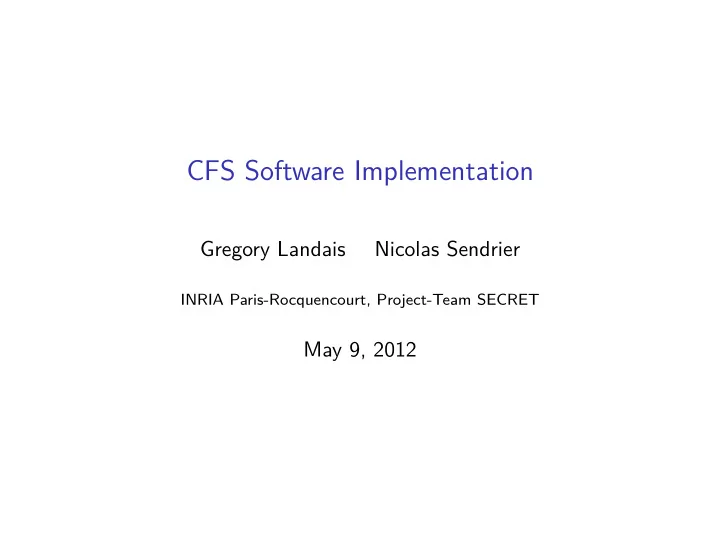

CFS Software Implementation Gregory Landais Nicolas Sendrier INRIA Paris-Rocquencourt, Project-Team SECRET May 9, 2012
CFS First code-based signature scheme. Relies on : ◮ hardness of the syndrome decoding problem ◮ the undistinguishability of a binary Goppa code Timeline : 2001 Publication by N. Courtois, M. Finiasz, N.Sendrier. 2004 FPGA implementation, signing time under 1 second. 200? Unpublished Bleichenbacher’s attack. 2010 Parallel CFS. 2011 Distinguisher for low rate Goppa codes.
CFS instance A CFS instance is defined by a binary Goppa code Γ : ◮ of length n ≤ 2 m ◮ of support L = ( α 0 , . . . , α n − 1 ) , an ordered sequence of distincts elements of F 2 m ◮ of polynomial generator g of degree t ◮ with an algebraic t -error correcting procedure ◮ of dimension k ≤ n − m × t ◮ of parity check matrix H ∈ { 0 , 1 } n × ( n − k ) Parameters : m , t Public key : H Secret key : L , g
CFS function sign ( M ) ⊲ input: message M S ← syndromes ( M ) ⊲ S is a family of syndromes (typically obtained by hashing) for all s ∈ S do e ← decode ( s ) if e � = fail then return e , s end if end for end function Probability of success of the decoding ≈ 1 t !
Let’s open the black box function sign ( M ) ⊲ input: message M S ← syndromes ( M ) for all s ∈ S do σ ( z ) ← solve _ key _ eq ( s ) e ← roots ( σ ( z )) if card ( e ) = t then return e , s end if end for end function
Generating the family of syndromes 1. Counter appending : append a counter to the message before hashing it to a syndrome. ◮ Hashing performed on the target architecture ◮ Variable signature size ◮ No Parallel-CFS counter measure BAD IDEA 2. Complete decoding : hash the message to a unique syndrome and try to guess δ elements of the corresponding error pattern. ◮ Adds a recoverable signature failure probability BETTER IDEA
Loop body diet function sign ( M ) ⊲ input: message M s 0 ← hash ( M ) for all e ∈ E do ⊲ E is the set of error pattern of weight δ s ← s 0 + syndrome ( e ) σ ( z ) ← solve _ key _ eq ( s ) if σ ( z ) splits in F 2 m [ z ] then return roots ( σ ( z )) , e end if end for end function
Let’s count critical non critical ( m , t ) type (1) (2) (3) (1)+(2)+(3) (4) (5) (18,9) BM 58 180 840 1078 2184 3079.1 (18,9) Pat. 38 329 840 1207 1482 3079.1 (20,8) BM 52 144 747 943 1950 3024.6 (20,8) Pat. 34 258 747 1039 1326 3024.6 (1) syndrome adjustment (4) initial syndrome (2) key equation solving (5) root finding (3) split checking Table: Number of field operations (excluding additions) per decoding
Finite field operations Store logarithm and the exponentiation of each element in base α , a primitive element of F 2 m . Space used : 2 20 2 20 × 2 × 4 B = 8192 KB F 2 10 2 10 × 2 × 2 B = 4 KB F Cache size of Intel XEON W3550 : L1 128 KB L2 1024 KB L3 8192 KB
Timings ( m , t , w , λ ) (18,9,11,3) (18,9,11,4) (20,8,10,3) (20,8,9,5) decoding 1 117 008 1 489 344 121 262 360 216 BM 14.70 s 19.61 s 1.32 s 3.75 s Pat 15.26 s 20.34 s 1.55 s 4.26 s sec bits 83.4 87.0 82.5 87.3 Table: Average number of algebraic decoding and running time per signature
Conclusion Signing with codes and 80 bits of security in less than 1 second is possible.
TODO list ◮ Make the code public ◮ Benchmark it (eBACS) ◮ Bit-slice it (joint work with Peter Schwabe) ◮ FPGA it (joint work with Jean-Luc Beuchat)
Thank you Questions ?
Recommend
More recommend